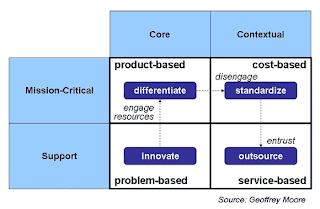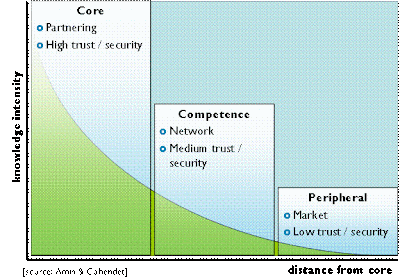- Supply and Fit (September 2000)
- Identifying Components 2 (October 2001)
- Opportunities in the Insurance Ecosystem (December 2004)
- Business Strategy Planning for the Service Economy (May 2006)
The biological approach to creating business and software services is radically different to the solution-driven approach, and is based on biological and ecological metaphors.
- First we identify an ecosystem, which may contain both human users and existing artefacts.
- Then we identify services that would be meaningful and viable in this ecosystem.
- Then we procure devices that enable the release and delivery of these services into the ecosystem.
Solution-Driven (Specific)
|
Solution-Driven (General)
|
Evolution-Driven
|
| Identify Business Problem Identify "Users" Negotiate Requirements Define Solution | Identify Domain Identify Domain Experts Define Requirements Design Solution Kit | Identify Ecosystem Identify Services Procure and Release Devices |
| Experimental SOA | Enterprise SOA | Ecosystem SOA |
(Some people use the term Web Oriented Architecture (WOA) for what I'm calling Ecosystem SOA.)
If we regard these as phases of maturity, then we can have a straightforward roadmap from left to right, as in for example the CBDI SOA Roadmap. However, some organizations may need to tackle these styles of SOA in parallel rather than in sequence.
A service portfolio plan for Enterprise SOA can be based on an enterprise model that identifies the capabilities of the enterprise and clusters these into domains. In the CBDI Forum's SAE methodology, the domains are classified as Core and Contextual according to a matrix derived from Geoffrey Moore. (Note how the domains migrate around the matrix over time.) See for example my blogpost Tesco outsources core eCommerce.

A similar model, derived from Amin and Cohendet's book Architecture of Knowledge, explicitly describes Core and Periphery in terms of knowledge intensity. In other words, the reason something is classified as Core is because it encapsulates some important (strategic) knowledge.

For example, an insurance company knows more about insurance than about cars, so when providing car insurance it may decide to partner with other organizations that know more about cars than about insurance. This results in a composition of insurance-related services and car-related services (for example, determining the insurable value of a used car). Such compositions can be either directed (in other words, composed by a single dominant player) or collaborative (in other words, emerging from the interaction between multiple players within the ecosystem).
For example, an online retailer knows about her products and services, but doesn't wish to become an expert in credit card handling, or to be responsible for data protection and security, so she delegates these concerns to a specialist provider that knows more about these matters.
Similar considerations can apply to industry consortia, such as ACORD (for the insurance market). ACORD can define generic service-based assets (such as models, schemas, interfaces and so on) for insurance. However, insurance companies will also wish to use generic service-based assets to cover requirements that are not insurance-specific, such as customer management or complaints handling, where ACORD may not be able to add any knowledge-value, and it would be appropriate for ACORD to regard these as peripheral to its own activities rather than core.
So one approach to Ecosystem SOA is to push out from the enterprise into the ecosystem. John Hagel calls this Inside-Out Architecture, which he contrasts with Outside-In Architecture. (See my post on Outside-In Architecture.)
An Outside-In Architecture starts with a model of (the flows of) knowledge and value in the ecosystem as a whole. The strategic question for an enterprise is how to find way of both contributing value to the ecosystem, and drawing value from the ecosystem, through the provision of ecologically viable services.
For example, a telecoms company might reasonably consider that its core competence is something to do with communications. So a positional strategy would drive it to a dominant position in the middle of a large communication ecosystem, providing a platform of services that add value to a diverse range of communication activities by other people. The dominant position would allow it to negotiate a strong share of the value generated.
However, respect for the ecosystem would lead it to leave sufficient value to third parties to maintain the economic health of the remainder of the ecosystem. Instead of a simple positional strategy, a relational strategy (based on mutual trust with ecosystem partners) should produce a more sustainable and ecologically sound ecosystem.
No comments:
Post a Comment